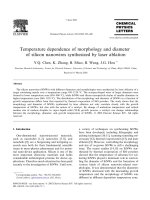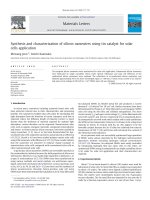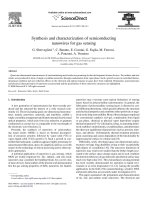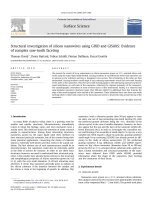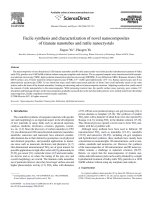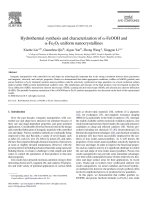- Trang chủ >>
- Khoa Học Tự Nhiên >>
- Vật lý
Synthesis and characterization of silicon nanowires using tin catalyst for solar cells application
Bạn đang xem bản rút gọn của tài liệu. Xem và tải ngay bản đầy đủ của tài liệu tại đây (554.21 KB, 3 trang )
Synthesis and characterization of silicon nanowires using tin catalyst for solar
cells application
Minsung Jeon
⁎
, Koichi Kamisako
Department of Electronic and Information Engineering, Tokyo University of Agriculture and Technology, 2-24-16 Nakacho, Koganei, Tokyo 184-8588, Japan
abstractarticle info
Article history:
Received 20 November 2008
Accepted 6 January 2009
Available online 8 January 20 09
Keywords:
Sn-catalyzed SiNWs
Reflectance
Solar cells
Phosphorous diffusion
VLS mechanism
Hydrogen radicals
Tin-catalyzed silicon nanowires were synthesized for solar cells application. Voluminous silicon nanowires
were fabricated on single crystalline silicon wafer. Optical reflectance and solar cell efficiency of the
synthesized silicon nanowires were explored. The reflectance of as-synthesized silicon nanowires was
obtained approximately 5% in the short wavelength region (λb 500 nm). A short circuit current of 2.3 mA/cm
2
and open circuit voltage of 520 mV for 1 cm
2
SiNWs solar cell was obtained.
© 2009 Elsevier B.V. All rights reserved.
1. Introduction
In recent years, nanowires including nanorods based solar cells
have attractive interest due to their characteristics and processing
benefits. The nanowires-enabled solar cells allow for decoupling the
light absorption from the direction of carrier transport, such that in
materials where the diffusion length of minority carriers is much
shorter than the thickness of material required for optimal light
absorption, current densities can be improved. Nanostructure solar
cells, such as organic–inorganic materials, compound semiconductor
and hetero- or homo-junction silicon structure, have been studied by
many researchers [1–5]. Law et al. has been demonstrated for dye-
sensitized solar cells using ZnO nanowires and produced an efficiency
of 1.5% [2]. Huynh et al. have been studied polymer matrix solar cells
using CdSe nanorods, with efficiency of 1.7% [3]. These results indicate
that the nanowires are attractive to enhance charge transport in
nanostructures solar cells compared with conventional solar cells or
other nanostructured solar cells.
In particular, silicon nanowires (SiNWs) are irresistible materials in
the semiconductor industry because the bulk properties of silicon are
well-known. Moreover, it can easily dope impurities to fabricate n- or
p-type Si semiconductor [6,7]. The SiNWs have been synthesized by
using various methods and metal catalysts via well-known vapor–
liquid–solid (VLS) mechanism [8,9]. Moreover, various materials, such
as Au, Al, Ga, In, Pb, Sn and Zn [8–15], have been used for synthesis of
silicon nanostructures. Recently, hetero-junction solar cell usin g
SiNWs have been demonstrated by Tsakalakos et al [4]. They fabricated
Au-catalyzed SiNWs on flexible metal foil and produced a current
density of ~1.6 mA/cm
2
for 1.8 cm
2
cell. Similar structures have been
demonstrated by Thony et al. They fabricated an all-inorganic SiNWs
solar cell using Au thin film and colloidal nanoparticles. The short
circuit current (J
sc
) and open circuit voltage (V
oc
) of the fabricated cells
were 0.53 mA/cm
2
and 125 mV, respectively [5]. As mentioned above,
Au nanoparticles are well-used metal catalyst and it easily synthesizes
the SiNWs at low temperature. However, it is known to be a deep level
impurity in silicon. In contrast with Au, tin (Sn) appears to be the
favorable catalyst because the Sn–Si alloy has relatively low eutectic
temperature of 232 °C [16] and forms with extremely low content of
the elemental semiconductors.
In our previous work, we successfully synthesized large quantities
of SiNWs using various materials by the hydrogen radical-assisted
deposition method including hydrogen radicals pretreatment
[12,14,17–19]. Moreover, Sn-catalyzed SiNWs were easily controlled
by introducing hydrogen flow gas ratios [20]. In this letter, we
synthesized SiNWs using Sn nanoparticles on single crystalline silicon
(c-Si) wafer for solar cell application and their characteristics are
explored.
2. Experimental details
About 7 Ω cm boron-doped Cz silicon (100) wafers were used for
fabrication of solar cells. Sn metal thin film as catalyst was evaporated
on these c-Si wafers. The wafers were dipped in diluted hydrofluoric
(5% HF) solution to remove native oxide layer and rinsed in pure water.
Then, the wafers were immediately located into the evaporation
vacuum chamber. The Sn metal film was deposited in situ onto the Si
wafer by a thermal evaporation source at a rate of less than 1 nm/s.
Materials Letters 63 (2009) 777–779
⁎ Corresponding author. Tel./fax: +81 42 388 7446.
E-mail address: (M. Jeon).
0167-577X/$ – see front matter © 2009 Elsevier B.V. All rights reserved.
doi:10.1016/j.matlet.2009.01.001
Contents lists available at ScienceDirect
Materials Letters
journal homepage: www.elsevier.com/locate/matlet
After depositing a Sn film of approximately 7 nm thickness onto the Si
wafer, the wafer was transferred into the experimental chamber and
heated for 1 h at 400 °C. Hydrogen (H
2
) gas was introduced and then
hydrogen radicals generated by 2.45 GHz microwave were irradiated
on the sample surface to fabricate metal nanoparticles. For synthesis
of SiNWs, silane gas as Si source was introduced into the experimental
chamber and it was reacted with hydrogen radicals. SiNWs were
synthesized for 20 min at 400 °C. Detailed other synthesis conditions
are summarized in Table 1.
The optical and morphologic al characteristics of the SiNWs
synthesized on c-Si wafer were estimated by spectrophotometer and
field emission scanning electron microscopy (FE-SEM). Furthermore, a
solar cell using the SiNWs synthesized on c-Si wafer was fabricated
after diffusion to form n
+
emitter. The current–voltage (I–V) properties
of the fabricated SiNWs solar cell were investigated by solar simulator
(AM 1.5, 100 mA/cm
2
).
3. Results and discussion
After synthesis of SiNWs on p-type c-Si wafer, phospho rous diffusion was
performed on the front surface using spin-on phosphors silicate g lass (PSG) coating.
The n the samples were diffused to fabricate p–n
+
junction in quartz tube for 30 min at
900 °C in N
2
ambient. After diffusion, the samples were dipped in 5% HF solution to
remove parasitic layer. Fig.1(a) ill ustrates a schematic of the SiNWs solar cell design in
this work. As shown in the Fig. 1(a), the silver (Ag) contacts with thickness of 180 nm
were evaporated on the surface of synthesized SiNWs without any transparent
conductive ox ide (TCO) film. To investigate the morphological property of SiNWs, a
FE-SEM observation was carried out after synthesis of SiNWs. Fig. 1(b) shows the top-
view (15° tilted) and cross-section (see inset of Fig. 1(b)) FE-SEM images of the SiNWs
fabricated on c-Si wafer.
As can be seen these figures, voluminous SiNWs were synthesized whisker-like.
The diameters of SiNWs on the bottom and top were approximately 60 nm and thinner
than 10 nm, respectively. Their lengths extended up to ~ 1.5 μm. Moreover, the SiNWs
were tapered and catalysts remained on the top of SiNWs. It indicates that the Sn-
catalyzed SiNWs are synthesized via VLS mechanism [8,9]. The detailed mechanisms
were well described elsewhere [14]. After diffusion, the surface morphologies were also
observed. Here, the doping level in the silicon nanowires, which is measured by
secondary ion-microprobe mass spectrometer, was estimated to be 1.4×10
20
atom/cm
3
base on planar Si wafer. Fig. 1(c) shows the FE-SEM image of the phosphorous-diffused
SiNWs. The shapes of SiNWs after formation of pn junction were slightly curved.
As mentioned above, we expect the SiNWs solar cells to show improved optical
properties compared with conventional planar Si solar cells. Fig. 2(a) shows the
photograph of the fabricated SiNWs solar cell. The surface color was dark brown in
appearance. To examine the optical properties of the SiNWs solar cell, a reflectance was
measured by spectrophotometer with integrating sphere. The reflectance of SiNWs and
typical planar c-Si wafer were compared as shown in Fig. 2(b). The reflectance of the
fabricated SiNWs solar cell represented less than 5% in the short wavelength regions
(λ b 500 nm). In contrast with this result, we have reported SiNWs synthesized on c-Si,
which have reflectance below 0.5% at λb 700 nm [20]. The difference of the reflectance
might be the effect of synthesis conditions, such as thickness of metal film and SiH
4
gas
flow. The reduction of reflectance is very helpful to improve the solar cell performance.
Therefore, further reduction of the reflectance will be expected from the optimization of
the synthesis conditions of SiNWs.
For analysis of the electrical properties, the I–V curve of the fabricated SiNWs solar
cell was measured by solar simulator under AM 1.5 (100 mA/cm
2
). Fig. 3 shows the
typical dark and light I–V curve of the SiNWs solar cell. Clear rectifying behavior and
power generation was distinguished in the 1 cm
2
SiNWs solar cell. The short circuit
current and open circuit voltage were obtained to 2.3 mA/cm
2
and 520 mV, respectively.
These values were higher than that of the hetero-junction SiNWs synthesized on metal
foil [4] and that of the homo-junction SiNWs solar cell [5]. As can be seen in Fig. 3, poor
I–V characteristics in dark and light conditions were observed. It is due to the high series
resistance and low shunt resistance. Theses limit the efficiency of the fabricated SiNWs
solar cell. Here, the high series resistance may be caused by the unconnected metal Ag
contact between the SiNWs and neighboring SiNWs. Moreover, it might be the effect of
Fig. 1. (a) Schematic of the SiNWs solar cells. FE-SEM images of the (b) as-synthesized SiNWs and (c) phosphorous-diffused SiNWs. All the scale bars represent 2.5 μm.
Table 1
Synthesis conditions for Sn-catalyzed SiNWs fabricated on c-Si (100) wafer
Hydrogen radical treatment Synthesis of SiNWs
Hydrogen (H
2
) gas flow [sccm] 100 180
Silane (SiH
4
) gas flow [sccm] – 15
Microwave power [W]40 40
Working pressure [Torr] 0.5 0.5
Temperature [°C] 400 400
Time [min] 1 20
778 M. Jeon, K. Kamisako / Materials Letters 63 (2009) 777–779
the Schottky barrier between the evaporated Al contact and silicon wafer because of
insufficient annealing conditions. For low shunt resistance, it might be the leakage
current from the front metal contact, i.e., local shunting across the solar cell.
In addition, the poor results were caused by the unoptimized diameter distribution
and the shapes of the synthesized SiNWs. It is typically not suitable for the application
of electrical and optical devices. Furthermore, unremoved metal nanoparticles caused
the reduction of the carrier lifetime, i.e., increasing surface recombination velocity.
Therefore, the sizes and impurity removal must be controlled for further improvement.
Moreover, the improvement of the cell performance owing to the deposition of TCO
films, such as indium–tin oxide and fluorine doped tin oxide, on the surface of synthe-
sized SiNWs will be expected.
4. Conclusion
We have demonstrated tin-catalyzed silicon nanowires solar cells
fabricated by the hydrogen radical-assisted deposition method on a c-
Si wafer. This SiNWs solar cell structure is a promising candidate for
future photovoltaic application. In particular, it is possible to reduce
the thickness of Si base substrate more thinly. For improvement of
conversion efficiency of the SiNWs solar cells, the reduction of the
contact resistance and optimization of the nanowire sizes will be
considered and the results will be presented near future.
References
[1] Baxter JB, Aydil ES. Appl Phys Lett 2005;86:053114.
[2] Law M, Greene LE, Johnson JC, Saykally R, Yang P. Nature Mater 2005;4:455.
[3] Huynh WU, Dittmer JJ, Alivisatos AP. Science 2002;295:2425.
[4] Tsakalakos L, Balch J, Fronheiser J, Korevaar BA, Sulima O, Rand J. Appl Phys Lett
2007;91:233117.
[5] Thony P, Delsol R, Jaussaud C, Rondel N, Rouvelere E, Poncet S, et al. Proc. 23rd
European PVSEC, Valencia, Spain; Sep. 2008, pp. 670–4.
[6] Pan L, Lew KK, Redwing JM, Dickey EC. J Cryst Growth 2005;277:428.
[7] Kimukin I, Islam MS, Williams RS. Nanotechnology 2006;17:S240.
[8] Wagner RS, Ellis WC. Appl Phys Lett 1964;4:89.
[9] Givargizov EI. J Crystal Growth 1975;31:20.
[10] Wang Y, Schmidt V, Senz S, Gosele U. Nature Nanotech 2006;1:186.
[11] Sunkara MK, Sharma S, Miranda R, Lian G, Dickey EC. Appl Phys Lett 2001;79:1546.
[12] Jeon MS, Kamisako K. Mater Lett 2008;62:3903.
[13] Zhang J, Jiang F, Yang Y, Li J. J Cryst Growth 2007;307:76.
[14] Jeon MS, Uchiyama H, Kamisako K. Mater Lett 2009;63:246.
[15] Yu JY, Chung SW, Heath JR. J Phys Chem B 2000;104 :11864.
[16] Olesinski RW, Abbaschian GJ. Bull Alloy Phase Diagr 1984;5:273.
[17] Jeon MS, Kamisako K. J Nanosci Nanotechnol 2008;8:5188.
[18] Jeon MS, Tomitsuka Y, Kamisako K. J Ind Eng Chem 2008;14:836.
[19] Jeon MS, Kamisako K. J Alloys Compd 2008, doi:10.1016/j.jallcom.2008.09.035.
[20] Jeon MS, Uchiyama H, Tomitsuka Y, Maishigi K, Kamisako K. Proc. Renewable
Energy 2008, Busan, Korea; Oct. 20 08.
Fig. 3. I–V characteristics of the fabricated SiNWs solar cell under dark and light
conditions.
Fig. 2. (a) Photograph of the fabricated SiNWs solar cell. (b) The difference of reflectance
between conventional planar c-Si solar cell and SiNWs solar cell.
779M. Jeon, K. Kamisako / Materials Letters 63 (2009) 777–779

![Tài liệu Báo cáo khoa học: Specific targeting of a DNA-alkylating reagent to mitochondria Synthesis and characterization of [4-((11aS)-7-methoxy-1,2,3,11a-tetrahydro-5H-pyrrolo[2,1-c][1,4]benzodiazepin-5-on-8-oxy)butyl]-triphenylphosphonium iodide doc](https://media.store123doc.com/images/document/14/br/vp/medium_vpv1392870032.jpg)
